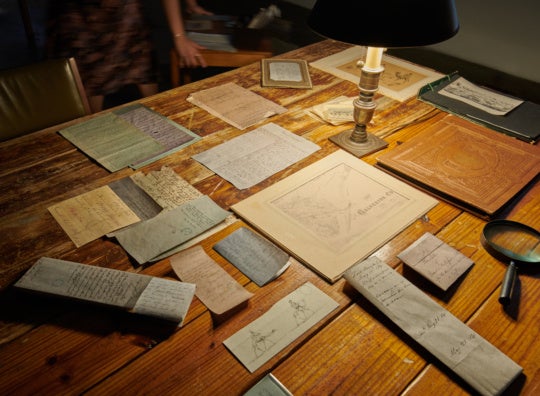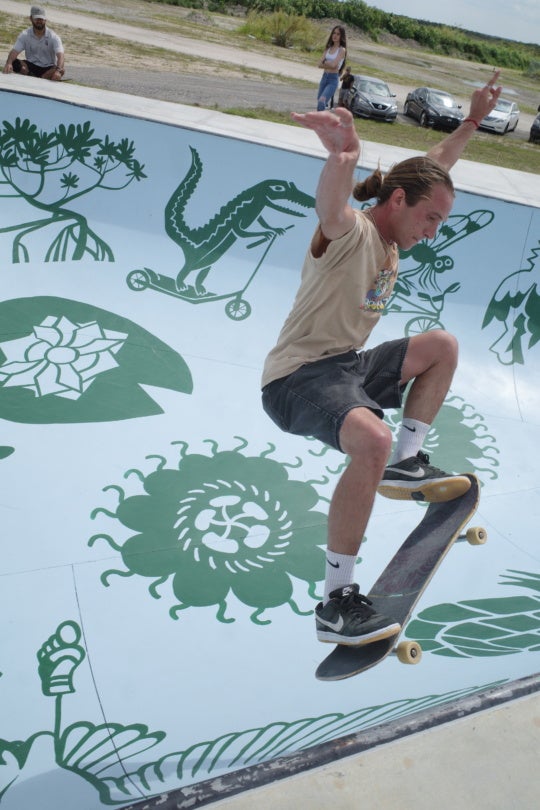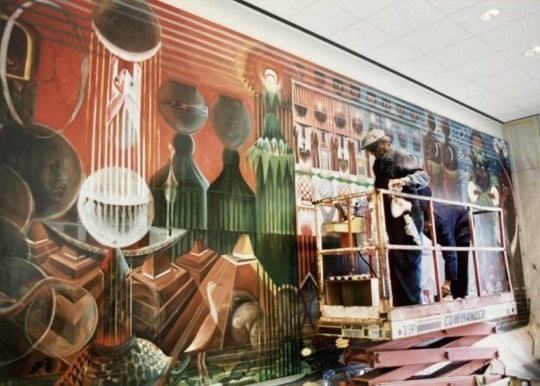
The upcoming Al Taylor [1948-1999] exhibition at the High Museum of Art, opening November 17, has been a passion project for Michael Rooks, the museum’s curator of modern and contemporary art since 2010. Titled “What Are You Looking At?,” it contains 150 works and is the first major survey of his work in the United States. Rooks first became familiar with Taylor’s work while visiting another artist’s studio in 1998, when he was assistant curator at the Museum of Contemporary Art, Chicago. His idea for a major survey of Taylor’s work gathered momentum during his time in Honolulu, from 2003 to 2008, where he worked at the Honolulu Contemporary and then the Honolulu Academy of Arts. But it had to put on the back burner when he went to work for the commercial gallery Haunch of Venison in New York in 2008. Excited that this important exhibition is finally happening, and in Atlanta no less, I wanted to know more about the effort that has gone into it. Here’s what Rooks had to say.
Who was Al Taylor?
Al Taylor was born in Springfield, Missouri, and possessed the Midwestern virtues of being solid, down-to-earth, and curious about the world around him, which in some ways seems to reflect the unobstructed openness of the prairies. He studied at Kansas City Art Institute in the late ’60s where he met the artist Stanley Whitney, who was one of his closest friends until he died in 1999. During his years at KCAI he traveled often to New York and attended summer school at Yale University. He also spent his last fall semester in New York in the Whitney Independent Study Program.

Who were his peers, friends, rivals?
Originally, Taylor wanted to be a painter, and in the course of his studies and travels to New York, he met abstract painters of earlier generations, such as Larry Poons, Kenneth Noland, Robert Mangold, Mel Bochner and Robert Moskowitz. During those early years he supported himself by working as a studio assistant to various artists, including Dan Christensen, and as an art handler, until he began working as an assistant to Robert Rauschenberg in 1975. Through Rauschenberg, he met Cy Twombly, Brice Marden and James Rosenquist. He remained very close to Rauschenberg and Rosenquist, who were among his most faithful supporters. Other artists in the same orbit were Terry Winters, Harriet Korman, Joe Zucker, Stephen Mueller, and slightly older artists like Richard Tuttle and Barry Le Va.
If he had a rival, in the sense of an adversary, I would have to say that it was the cult of the artist as celebrity in the New York art world of the 1980s. Taylor was an artist who was rarely if ever self-reflexive in his work and when he left his studio, his work remained in the studio. His personal relationships were determined by, again, a kind of Midwestern uprightness of character that he possessed and which he valued in others, regardless of whether or not his friends were fellow artists.
You began developing this retrospective nearly a decade ago, while based in Honolulu. What took so long? How long has this been in the works at the High and what was the impetus to move forward?
I started working on this exhibition in 1998, when I first saw Taylor’s work in the studio of printmaker and art historian Christopher Cordes while gathering research for a catalogue raisonné of sculpture by the artist H. C. Westermann. Taylor died the following year, and so we never had the opportunity to meet, but Cordes spoke to Taylor about me – he knew who I was and that I was interested in his work. I’ve always remembered that and the fact that he knew my name established a bond between us, even though we never met. So I resolved to get to know him through his work and through his friends.
When I lived in Hawaii, I corresponded with his wife Debbie in New York, and she introduced me to many of Al’s friends and colleagues, like Hawaii artists Doug and Sharon Britt. Hawaii was a special place for Taylor, who first traveled there as an art handler. Debbie and I shared this love of Hawaii, so I began developing an exhibition in 2005 and received grants for it from the Warhol Foundation and the now defunct Rothschild Foundation – this was before the Taylor estate was represented by a gallery [Zwirner Gallery began representing the Al Taylor estate in 2007].
Ultimately, I had to return the grants when I left Hawaii for the mainland when I joined Haunch of Venison Gallery in 2008. By that time, the exhibition, my relationship to the work, and my friendship with the people who had supported Taylor’s work throughout his entire life was very, very personal. And it was, if I am honest, something that I made a silent vow to do because of this bond I felt with the artist. We had never met, yet I felt I had known him all my life. For that reason, the idea for the show stayed with me until I joined the High Museum in 2010. I’ve been trying to get this exhibition scheduled since joining the museum and it was our new director, Rand Suffolk, who ultimately gave me the green light about 18 months ago.
I had a meeting in a conference room at the High’s offices back in July, and one wall was covered with images of Al Taylor works and color-coded Post-its. I was fascinated. What was that about?
The exhibition is actually a tightly curated retrospective covering the span of his career, from his first print to his last drawing. Taylor made approximately 6,000 drawings, hundreds of sculptures and nearly 200 published prints. There is so much work, and all of it of exceptional quality, that it was extremely difficult at first to select works. The framework for the show changed several times from Hawaii to Atlanta. But this time allowed me to develop a more-or-less rigid matrix for the exhibition that also allowed the kind of cross-fertilization that demonstrates the synaptic chain of induction, deduction, association, and speculation that belied Taylor’s irrepressible elasticity of mind.
I decided to organize the exhibition around only those bodies of work in which there were examples of drawings, prints and sculptures. This interdependency between media allowed Taylor a wide range of variables with which to “change the rules” of systems that exist in logic and nature. To change the rules, Taylor actively contradicted and derailed assumptions, which engendered a process by which works might “create their own logic.” The conference room where you saw the wall of Xeroxed images with sticky notes is where I was attempting to trace Taylor’s “logic” in a visual way by mapping thematic and subjective strands of meaning between and among works across media.

How does this show tie in with the 2013 show of his work that you also curated, “Drawing Instruments: Al Taylor’s Bat Parts and Endcuts”?
The focus show I did in 2013 allowed me to let off some steam after working on Taylor for so long, but it also provided an opportunity to try out some ideas that had to do with combining seemingly disparate bodies of work and teasing out the artist’s course of “logic” through interpretation. It was also an occasion for us to acquire two drawings for the High Museum.
How would you explain his work to the skeptical viewer?
Al Taylor was in many ways a hybrid explorer/scientist/mathematician/artist. His work was compelled by insatiable curiosity about the real world around him and the phenomenon behind its systems and orders. As an explorer, Taylor seemed to both follow and lead his work in exciting new directions as if they were traveling companions stirred by the potential for discovery across every new horizon. The physical and mental act of seeing/looking was a fundamental activity in Taylor’s studio. It was so primary that he himself suggested that “What are you looking at?” (our exhibition title) should be the epitaph carved on his tombstone.
The questions raised in Taylor’s works became poetic paradigms for seeing the world in entirely different ways that are always changing, never static, and shifting from one perspective to another. This voracious and omnivorous curiosity about the most quotidian things transformed his work – sculptures and related drawings and prints — into hypotheses for a series of unlikely and humorous observations grounded in the gritty physicality of the real world. Like another artist I’m close to, who operated outside the mainstream of the gallery system in New York – H. C. Westermann – Taylor was an artist whose work was first and foremost about respecting the limitlessness of the imagination and integrity of character. This endowed his work with an unadorned humanity, humor, and humble nobility.

What’s your favorite piece in this show and why?
Pet Stain Removal Device, 1988, because of its Rube Goldbergian absurdity, Duchampian logic, formal gracefulness, and its wicked humor.
Which work has the best backstory?
The sculpture 6-8-9 is the first thing that you would encounter in Taylor’s former Franklin Street studio and I will always remember seeing it on my first visit there to meet Debbie Taylor. It has five black rings that were scavenged from bar stools and they are attached to a wooden dowel mounted at a right angle to the wall. Two of the rings are partially painted white so that when you see the piece frontally, the numbers 6, 8, and 9 come into view as the rings overlap from front to back. It is a terrific visual allusion to art history from Marcel Duchamp to Victor Vasarely, but for me it evokes the series 0 Through 9 by Jasper Johns, in which all of the cardinal numbers are superimposed in one image. It is especially funny that Taylor used parts from bar stools to create an optical illusion as if the numbers 6, 8 and 9 are coming in and out of the focus of a blurred vision.

How did Hawaii inspire him?
He first traveled to Hawaii in 1987 as an art handler. He met and worked with Hawaiian people (as opposed to people who live in Hawaii) on an installation project in Maui and developed a bond with them, I’m guessing because of Aloha. The very real spirit of Aloha is something that is poignant if you are open to it – meaning if you can set aside expectations and stereotypes about Hawaii created by the American travel industry in the 1940s and 1950s. Aloha is a sharing of each other in the present. For example, when you are given a lei, the presenter does not lean-in to kiss you but to share breath – you both breath in at that moment. It’s the breath of life. This is exactly the kind of thing that would interest Taylor – a detail that very few tourists would observe but which is so beautiful. He had a habit of observing things that are often overlooked or ephemeral and conferring dignity upon them. The fact that as a haole (or outsider) he stayed with his Hawaiian friends while working in Maui suggests that they enjoyed each other’s friendship and mutual respect.

Why do you think he didn’t achieve as much recognition while he was alive?
He had actually shown quite often in group exhibitions in the United States from the early 1980s until his death and had several solo exhibitions in New York at Galerie Alfred Kren, Lorence Monk, David Nolan, and others. His career flourished during his lifetime in Europe when he began showing with Fred Jahn in Munich. There were two museum exhibitions organized in Europe during his lifetime – at Kunsthalle Bern and at Kunstmuseum Luzern. Unfortunately, he died several months before the Lucerne exhibition opened in 1999. So he had a great deal of recognition, just not in the US. I think he did not receive the recognition he deserved in the United States because the art system in New York was antithetical to who he was as a person – Taylor was not a self-promoter and was incapable of trading in celebrity or notoriety.
What do you make of artists who become more well-known posthumously? Is it that they were underappreciated and/or out of step with the art of their time? Or they weren’t good at promoting themselves?
I think it depends on the artist, the historical moment and the place where they are working and showing. For example, there is a lot of revisionism happening now to redress the absence of influential voices of color, and voices of women, that were unheard or ignored when the artists were alive because of an intrinsic bigotry prevalent in the art world of the past. Some artists are overshadowed by the larger-than-life personality or celebrity of others of their own generation or among their circle of influence. In the case of Al Taylor, time was not on his side. He died at the age of 51, just when he had really hit his stride as an artist, which was reflected in the extraordinary success he enjoyed in Europe. It was just a matter of time when we in the US (certainly not everyone) would discover in Taylor what we had been missing for two decades. He was also, as you suggest, not a self-promoter but this did not seem to affect his career outside the US.
Will the show travel?
Currently there are no other venues confirmed but there is interest and so we are hoping to line up a tour before the show closes next spring.




